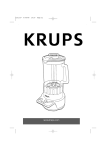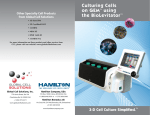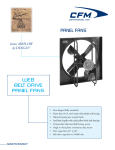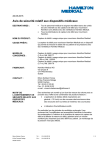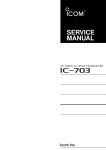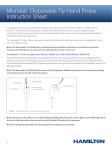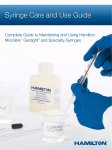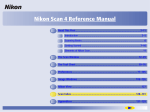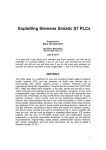Download Cell Culture Handbook
Transcript
BioLevitator Cell Culture Handbook Trademarks BioLevitatorTM, GEMTM, and LeviTubeTM are Trademarks of Global Cell SolutionsTM. Important Notice This guide may not be used or reproduced in any way whatsoever without the express written consent of HAMILTON Bonaduz AG. Copyright © 2010 HAMILTON Bonaduz AG, All Rights Reserved. Contents of this manual are subject to change without prior notice. Technical modifications reserved. Greatest possible care was used on the correctness of the information in this manual. If errors should be discovered nevertheless, HAMILTON is pleased to be informed about it. Regardless of this, HAMILTON cannot assume any liability for errors in this manual or for their consequences. Table of Contents TABLE OF CONTENTS TABLE OF CONTENTS ...........................................................................................3 1 INTRODUCTION ..............................................................................................4 1.1 Introducing the BioLevitator .......................................................................... 4 1.2 Introducing the GEM..................................................................................... 6 1.3 Culturing Cells in the BioLevitator................................................................. 8 1.3.1 Inoculation ............................................................................................. 8 1.3.2 Culture ................................................................................................. 10 1.3.3 Harvesting ........................................................................................... 11 2 PROTOCOLS ...............................................................................................13 2.1 2.2 2.3 2.4 2.5 2.6 3 Protocol 1: Preparation of the GEM ............................................................ 13 Protocol 2: Loading Assay in 24-Well Format ............................................. 14 Protocol 3: Inoculation and Culturing Cells on GEM in the BioLevitator...... 16 Protocol 4: Monitoring of BioLevitator Cultures........................................... 18 Protocol 5: Harvesting a Cell Suspension from a BioLevitator Culture ....... 20 Protocol 6: Preparing a GEM Suspension for Downstream Assays............ 22 TROUBLESHOOTING .................................................................................... 23 3.1 3.2 3.3 3.4 Troubleshooting the Inoculation Phase....................................................... 23 Troubleshooting the Culture Phase ............................................................ 24 Troubleshooting the Harvesting of Cells from the GEM .............................. 25 Getting Technical Assistance...................................................................... 26 BioLevitator – Cell Culture Handbook 3 Introduction 1 INTRODUCTION 1.1 Introducing the BioLevitator The BioLevitator (Figure 1) is a bench-top incubator and bioreactor hybrid capable of handling four independent and high density cell cultures. It eliminates peripheral instruments such as incubators and centrifuges, and minimizes manual handling. The BioLevitator utilizes the magnetic Global Eukaryotic Microcarrier (GEM) technology from Global Cell Solutions and integrates the relevance of 3D cell culture with the convenience of microcarrier culture. Why the BioLevitator? The BioLevitator is a scalable cell culture system that integrates 3D cell culture into a streamlined culture process. As a walkaway bench-top device, the BioLevitator allows the user to focus on value-added research and discovery rather than cell culture. Figure 1: The BioLevitator and key features 4 BioLevitator – Cell Culture Handbook Introduction Precise Environmental Control The compact incubator chamber monitors and maintains CO2 and temperature during cell expansion. On screen graphs track temperature, CO2, and pH (optional). Touch & Go Maintain four unique cultures at the touch of a button. The touch-screen interface provides users with intuitive and easy to program cell culture workflow. In addition, the ergonomic click-wheel allows quick navigation. Data Logging Complete culture reports, including metrics such as temperature, CO2, and pH are generated and saved at the end of each culture experiment. The culture reports can be easily transferred via USB stick from the BioLevitator to the PC. Control of the GEM Rotation of the LeviTube gently maintains the cells on the GEM in suspension and ensures optimal access to nutrients. Magnets integrated in the BioLevitator are used to pellet the cells for media exchange and cell harvesting. Convection Channel The convection channel with integrated fan is designed to maintain a homogeneous environment within the cell culture chamber. It is located on the left side of the instrument and can be easily replaced to limit contamination of the system. CO2 Control Integrated with a compact laboratory-grade controller, the BioLevitator ensures proper delivery of CO2. A sampling port on the top cover is available to monitor the chamber environment using a laboratory CO2 analyser. BioLevitator – Cell Culture Handbook 5 Introduction 1.2 Introducing the GEM The Global Eukaryotic Microcarrier (GEM) is a pipette-able and paramagnetic microcarrier for the culture of adhesion-dependent cell lines (Figure 2). Composed of an alginate core embedded with paramagnetic particles and coated with covalently bound adhesion molecules, the GEM is also an ideal matrix for three-dimensional biology. The GEM is available with 7 different coatings: § § § § § poly-D-lysine § laminin § basement membrane gelatin collagen I collagen IV fibronectin Why the GEM? The GEM is designed to provide an optimal cell culture surface for your preferred cell line while providing a vehicle for cell transfer through the drug discovery process. The GEM substrate supports high-density cell cultures in the BioLevitator. As a magnetic microcarrier, the GEM can be controlled during media change, harvesting, or assay washes. 75-150 µm in diameter Figure 2: The GEM and key features 6 BioLevitator – Cell Culture Handbook Introduction Alginate Core Alginate is an unbranched polysaccharide which gels in the presence of divalent cations, such as calcium. The GEM core is composed of a dense alginate hydrogel that allows for the exchange of ions and small molecules. Protein Coating A thin covalently bound coat of gelatin surrounds the alginate core of the GEM. This gelatin coat can also be modified with the addition of collagen I, collagen IV, fibronectin, laminin, poly-D-lysine or reconstituted basement membrane. Paramagnetic Particles Dispersed in the alginate core are small paramagnetic particles that serve to simplify culture manipulations and allow for automated cell culture. Cells on the GEM are easily handled during media change, harvesting, and assay washes. Assay on GEM The alginate GEM core is optically clear and nonautofluorescent. Absorbance, luminescence and fluorescence assays are easily performed with cells still attached to the GEM. Cells can also be transfected and cryopreserved directly on the bead. Easy Cell Harvesting Although it is recommended to keep cells on the GEM for most applications, some assays require a cell suspension. Short incubation with Accutase simply dissociates cells from the GEM leaving the alginate core intact. Trypsin with EDTA solubilizes the GEM. Pipette-able Microcarrier The GEM has a diameter of 75 - 150 µm and is easily pipette-able. As a pipette-able microcarrier, the GEM enables sampling, dispensing and transfer of cells without prior trypsinization. BioLevitator – Cell Culture Handbook 7 Introduction 1.3 Culturing Cells in the BioLevitator Cell culture in the BioLevitator, as with all cultures, consists of three phases: 1) inoculation, 2) culture, and 3) harvesting (Table 1). Phase Symbol Description Inoculation Loading of cells on the GEM substrate Culture Expansion of cells on the GEM substrate Harvesting Dissociation of the cells from the GEM Table 1: The three phases of cell culture in the BioLevitator. 1.3.1 Inoculation During the inoculation phase, cells attach to the GEM in three phases (Figure 3). First, rounded cells make contact with the GEM (adsorption). Cells then flatten on the side of contact and appear bell shaped (attachment). Finally, cells completely flatten down on the GEM, which supports normal cellular processes including growth (settling). Figure 3: The three phases of cell attachment to the GEM during the inoculation phase, illustrated with pictures of CHO cells. A successful inoculation will produce an even distribution of adhered cells across the entire GEM population, ensuring all the surface area available is utilized for 8 BioLevitator – Cell Culture Handbook Introduction expansion. Four critical variables need to be optimized to create a successful inoculation: 1) GEM type, 2) cell to GEM ratio, 3) agitation during inoculation, and 4) media type and volume. GEM Type The GEM exists with 7 different surface protein coatings. Different cells will show specificity for attachment to particular surfaces. The surface(s) promoting most attachment and growth can be easily identified in a binding assay, for example using the Adhesion Assay Kit (p/n GKT-5001). Cell to GEM Ratio Standard protocols inoculate 0.5 - 2 mL GEM with 2 - 6 x106 cells/mL GEM in 10 mL medium. The cells used for inoculation should be in logarithmic growth to limit initial lag phase. The inoculum should be a single cell suspension that is free of aggregates, which will cause heterogeneity. Agitation during Inoculation The BioLevitator provides a precise digital control of the agitation parameters during inoculation (Table 2). The Rotation period, Rotation pause, and Rotation speed describe the basic movement of the LeviTube. The Agitation period and Agitation pause are specific to the inoculation of cells requiring intermittent agitation. Parameter Definition Usual range Rotation period Rotation time in one direction 1 - 3 sec Rotation pause Pause between two rotation periods Rotation speed during rotation period Agitation time for intermittent inoculation protocols Agitation pause for intermittent inoculation protocols1 Time required for efficient loading of the GEM 0 sec Rotation speed Agitation period Agitation pause Protocol duration 50 - 100 rpm 1 - 2 min 0 - 60 min 4 - 24 hours Table 2: Inoculation parameters: definition and common range. [1] Some cells, e.g. fibroblasts, may require a constant agitation. The agitation pause is then set at 0 min. Agitation will ensure a homogenous inoculation and prevent clumping. Most cell types however do not inoculate under constant agitation but require intermittent agitation with an Agitation pause lasting 10 - 60 min. Increasing the Agitation pause will enhance cell loading whereas decreasing the Agitation pause will prevent clumping during inoculation. Observing the rate at which cells adhere to the GEM and therefore the Protocol duration can be done in a multi-well plate. Ideally, this occurs concurrently to identifying the ideal GEM type. BioLevitator – Cell Culture Handbook 9 Introduction Medium Type and Volume A variety of different media can be used for culture in the BioLevitator. A good starting point is to use a medium which supports the growth of a particular cell type in other systems. A richer medium such as DMEM/F12 may be needed for the initial stages of the culture, especially when cell densities are low. The use of higher serum concentration (10 - 20% serum) can increase cell viability during inoculation and loading to the GEM. The addition of medium supplements such as non-essential amino acids may also improve loading and growth in the beginning of the culture. Attachment efficiency is usually enhanced when cells are inoculated in a reduced volume. Cells have a greater chance of coming into contact with a GEM, and the conditioning effects on the medium are greater. Inoculation in the BioLevitator usually takes place in a 10 mL volume. 1.3.2 Culture Expanding the culture is easily accomplished following a successful inoculation. As with traditional culture, the media and its components must be maintained to ensure steady growth and good yields. Concurrently, rotation speed may be increased to maintain the GEM in suspension and reduce clumping. A successful expansion requires addition of medium, regular medium changes, and monitoring for clumping. Addition of Medium The usual procedure is to fill up medium to 50 mL, the maximal culture volume of the LeviTube, after inoculation (Figure 4). A progressive scheme for medium addition may be developed, if a particular cell type is sensitive to osmotic shock and tend to fall from the GEM upon medium addition. Replenishment scheme1 Time 6 hours day 3 Volume 40 mL 40 mL Type addition change [1] May vary depending on the cell type or the inoculation and culture conditions. Figure 4: Example medium replenishment for the culture of CHO cells. 4 million CHO cells were inoculated on 1 mL GEM in 10 mL DMEM/F12 with 10% FCS. At the end of the inoculation (6 hours), 40 mL medium was added. On day 3, 40 mL medium was changed. 10 BioLevitator – Cell Culture Handbook Introduction Medium Change Careful medium replenishment can directly impact the yields achieve at the end of the culture. Media change has 3 functions: 1) replacing nutrients depleted during the culture, 2) removing metabolic products which inhibit growth, and 3) help control pH. The frequency of media replenishment and the volume to be changed depend on the cell type, the cell density, and the culture medium. A typical procedure is to start with replenishing 50 - 80% of the medium volume every 3 days (Figure 4). Monitoring of the Culture During the protocol optimization phase, daily monitoring of the culture is common practice. Monitoring includes microscopic observation of cells on the GEM (Figure 5) and cell counting. Hoechst stain facilitates the observation of cells on the GEM. A B Figure 5: Microscopic monitoring of the culture of MDBK in the BioLevitator. Cells were observed under microscope (A) and after Hoechst staining (B). 1.3.3 Harvesting Keeping cells on the GEM is the ideal method for most applications and assays including viral transduction, cryopreservation, or fluorescent cell-based assays. However, some assays (e.g. flow cytometry) may require cells in suspension. In which case, standard harvesting methods including Trypsin with EDTA or Accutase can be used. Since the alginate core uses calcium ions to gel, in the presence of Trypsin with EDTA the GEM dissolves. Left behind are the cells in suspension and a small number of para-magnetic particles which can be removed with the Cube Magnet. BioLevitator – Cell Culture Handbook 11 Protocols 2 PROTOCOLS 2.1 Protocol 1: Preparation of the GEM The preparation of the GEM consists essentially in a wash step to remove the storage buffer and allow the GEM substrate to equilibrate with the culture medium. Omitting this step may lead to sub-optimal loading of the cells to the GEM. Materials § GEM Supply Kit § Cube Magnet § Complete cell culture medium § Pipettor and sterile tips Procedure 1. Hold a 2 mL-vial of GEM over the Cube Magnet to immobilize the GEM (Figure 6). Figure 6: GEM immobilization using the Cube Magnet. 2. Carefully aspirate off the storage buffer, and discard. 3. Away from the Cube Magnet, add 1 mL of culture medium and use a pipette to mix the slurry. 4. Place the vial back on the Cube Magnet to sediment the GEM and aspirate off the supernatant and add 1 mL of culture media. Note: Store the pre-washed GEM at 4°C for up to 1 month. BioLevitator – Cell Culture Handbook 13 Protocols 2.2 Protocol 2: Loading Assay in 24-Well Format The loading assay described below is a qualitative analysis of the adhesion of cells to the GEM and a useful tool to: § identify the optimal GEM type for loading and growth of a particular cell type § estimate the time required for optimal loading § determine the medium requirements (e.g. serum concentration) for loading of a particular cell type to the GEM Materials § GEM Supply Kit § Cube Magnet § 1 - 3 x105 cells in exponential growth phase § Complete cell culture medium § Pipettor and sterile tips § Serological pipettes § Conical tubes Procedure 1. Determine the conditions to be tested and calculate the amount of starting material required. Use the Table 3 to determine the amounts of starting materials required. Amounts per well of a 24-well plate GEM 50 µL Cells 1 - 3 x105 Culture medium (final) 1 mL Table 3: Suggested amounts of starting material per well of a 24-well plate. 2. Wash the GEM once with media to remove the storage buffer (2.5 mM CaCl2, 10 mM Hepes). Refer to Protocol 1 for the detailed procedure. 3. Per well of a 24-well plate, pipet 450 µL medium and add 50 µL pre-washed GEM. 4. Place the plate in the cell culture incubator during the preparation of the cell suspension. 5. Per well of a 24-well plate, prepare a single cell suspension containing 1 – 3 x 1 0 5 cells in 500 µL medium and transfer the inoculum to the GEM / medium preparation in the plate. Use a single cell suspension for inoculation. Cell aggregates lead to heterogeneous loading. 14 BioLevitator – Cell Culture Handbook Protocols 6. Shake the plate gently and place it in the cell culture incubator. 7. Monitor cell loading to the GEM every 2 hours and cell growth after 24 - 48 hours. Refer to Figure 3 to identify the different stages of loading. Note the conditions required for good attachment (settling): the GEM type, any changes to the medium requirements as well as the time for good loading to occur. BioLevitator – Cell Culture Handbook 15 Protocols 2.3 Protocol 3: Inoculation and Culturing Cells on GEM in the BioLevitator Materials § BioLevitator One Month Supply Kit (includes GEM and LeviTubes) § Cube Magnet § BioLevitator § 2 – 6 x106 cells in exponential growth phase § Complete cell culture medium § Pipettor and sterile tips § Serological pipettes § Conical tubes Procedure (Figure 7) 1. Turn the BioLevitator on and start the temperature and CO2 regulation. 2. Wash the GEM with media to remove the storage buffer. Refer to Protocol 1 for the detailed procedure. 3. Pipet 3 mL medium to a LeviTube and add 1 mL pre-washed GEM. 4. Place the LeviTube in the BioLevitator during the preparation of the cell suspension. 5. Prepare a single cell suspension containing 2 - 6 x106 cells in 6 mL medium and transfer the inoculum to the GEM / medium preparation in the LeviTube. Use a single cell suspension for inoculation. Cell aggregates lead to heterogeneous loading. 6. Place the LeviTube in the BioLevitator and start the desired Experiment. Refer to the BioLevitator User Manual (p/n 624206) for further information. 7. After inoculation, monitor cell loading to the GEM and GEM clumping. During culture, monitor growth and GEM clumping daily. Refer to Figure 3 to identify the different stages of loading. The monitoring of BioLevitator cultures is described in Protocol 4. 8. At the end of the inoculation phase or the day after, add 40 mL medium to the LeviTube to bring the total culture volume to 50 mL. Medium may be progressively added, if a particular cell type is sensitive to osmotic shock and tend to fall from the GEM upon medium addition. 9. Change up to 40 mL medium every 2 to 3 days. The frequency and the extent of medium change will depend on the cell type, the cell density, and the culture medium. Adjustment of the medium replenishment scheme may be required to maximize final yields. 16 BioLevitator – Cell Culture Handbook Protocols Figure 7: Inoculation workflow. BioLevitator – Cell Culture Handbook 17 Protocols 2.4 Protocol 4: Monitoring of BioLevitator Cultures Daily monitoring of the culture is common practice, especially during the protocol optimization phase. Procedures for microscopic observation of cells on the GEM and cell counting are described below. Materials § 1.5 mL tube § 96-well plate (flat bottom, optically clear) § Pipettor and tips § Ca2+ / Mg2+ free PBS § Accutase (or alternative harvesting solutions) § Hemocytometer Procedure 1. Mix well the content of the LeviTube by pipetting. Take a 550 µL sample from the cell culture and place it in a 1.5 mL tube. 50 µL will be used for microscopic observation and 500 µL for cell counting. Note: A 1 mL sample may be required for monitoring, if the amount of cells available for counting is too low. 2. Place 50 µL of the cell culture sample in a well of a 96-well plate and observe under the microscope. The objective of the microscopic observation is to verify that the culture parameters set lead to good cell growth on the GEM while limiting clumping. You may use Table 4 to analyze the culture. Very low Low Medium High Very high GEM with a least 1 cell o o o o o Empty GEM o o o o o GEM clumps o o o o o Single cells in suspension o o o o o Cell clumps in suspension o o o o o Table 4: Aid to the microscopic observation of BioLevitator cultures. Note: Additional staining of the nuclei with Hoechst stain facilitates observation of the cells on the GEM. 3. Use the Cube Magnet to pull down the cells on GEM from the remaining 500 µL sample, aspirate the culture medium and wash with 1 mL Ca 2 + / Mg 2 + free PBS. 4. Add 100 µL Accutase and use a pipette to mix. 18 BioLevitator – Cell Culture Handbook Protocols 5. Incubate until the GEM dissolve leaving behind a single cell suspension and partially dissolved GEM. Visually monitor progress under the microscope to determine the time required for a particular cell type to detach from the GEM. Short incubation with Accutase will only partially dissolve the GEM, which limits the release of the para-magnetic particles. Trypsin with EDTA will dissolve the GEM completely, leaving behind a single cell suspension and the para-magnetic particles. 6. Use the Cube Magnet to remove the GEM remnants and count the cells with a hemocytometer. BioLevitator – Cell Culture Handbook 19 Protocols 2.5 Protocol 5: Harvesting a Cell Suspension from a BioLevitator Culture Materials § Serological pipettes § Ca2+ / Mg2+ free PBS § Accutase (or alternative harvesting solutions) § Hemocytometer Procedure (Figure 8) 1. Stop the running experiment and remove the LeviTube from the BioLevitator. 2. Pull the confluent GEM substrate to the bottom of the tube with the Cube Magnet and aspirate the culture medium. 3. Gently wash the GEM substrate with 10 mL of Ca2+ / Mg2+ free PBS. 4. Add 10 mL Accutase and gently mix the solution with a pipette. 5. Return the LeviTube to the BioLevitator and start the Harvesting protocol. Visually monitor progress under the microscope to determine the time required for a particular cell type to detach from the GEM (Protocol duration). Short incubation with Accutase will only partially dissolve the GEM, which limits the release of the para-magnetic particles. Trypsin with EDTA will dissolve the GEM completely, leaving behind a single cell suspension and the para-magnetic particles. Parameter Usual range Rotation period 1 - 3 sec Rotation pause 0 sec Rotation speed 70 - 100 rpm Protocol duration 5 - 30 min Table 5: Harvesting parameters and suggested range. 6. Pull the remnants of the GEM substrate to the bottom of the tube using the Cube Magnet and transfer the cell suspension to a new 50 mL tube. 7. Take an aliquot of the cell suspension for cell counting. Cells are ready for downstream assays or other applications. 20 BioLevitator – Cell Culture Handbook Protocols Figure 8: Workflow describing the harvesting of a cell suspension from a BioLevitator culture with Accutase. BioLevitator – Cell Culture Handbook 21 Protocols 2.6 Protocol 6: Preparing a GEM Suspension for Downstream Assays Materials § Serological pipettes § Ca2+ / Mg2+ free PBS § Accutase (or alternative harvesting solutions) § Hemocytometer Procedure 1. Stop the running experiment and remove the LeviTube from the BioLevitator. 2. Mix the content of the LeviTube by pipetting. Take a 500 µL sample from the cell culture and count the cells (see Protocol 4). 3. Pull the confluent GEM substrate to the bottom of the tube with the Cube Magnet and aspirate the culture medium. 4. Gently wash the GEM substrate with 10 mL of Ca2+ / Mg2+ free PBS. Repeat if necessary. The cells on GEM are ready for downstream assays or other applications. Pipette the required volume of GEM suspension to obtain the desired number of cells per well. 22 BioLevitator – Cell Culture Handbook Troubleshooting 3 TROUBLESHOOTING 3.1 Troubleshooting the Inoculation Phase Observations Optimization alternatives 1. Poor attachment of cells to the § Only a few cells are visible on the GEM at the GEM. Many cells are in suspension. Some cells may form aggregates in suspension rather than loading on the GEM. § § § § § 2. Loading on the GEM is heterogeneous. Many GEM with no cells attached are observed. § 3. GEM with cells attached form clumps (with at least 5 GEM per aggregate) § § § § BioLevitator – Cell Culture Handbook end of the inoculation phase. GEM are usually inoculated with only 8 - 15 cells per bead (. Hoechst staining facilitates the observation of cells on the GEM. Cell may have limited affinity for the GEM coating used. Cells have a rounded morphology and poor flattening. A better coating may be identified using the Adhesion Assay Kit (p/n GKT-5001). Increase Agitation pause and / or Inoculation duration to provide more time for the cells to load on the GEM. Reduce Rotation speed. A speed of 50 rpm is usually sufficient during inoculation. Ensure cells have been harvested at the optimum time and with optimized procedure. Optimize culture medium composition and volume. Change to a more enriched medium. Reduce initial culture volume. Reduce Agitation pause to increase the frequency of homogenization during inoculation. Use a single cell suspension for inoculation. Check the cell to GEM ratio used for inoculation (inoculate 4 - 6 x106 cells on 1 mL GEM). Reduce Agitation pause. Some cell types (e.g. some fibroblast cell lines) load with continuous homogenization, i.e. Agitation pause is 0 sec. Reduce Inoculation duration. 23 Troubleshooting 3.2 Troubleshooting the Culture Phase Observations Optimization alternatives 1. Cells detach from the GEM. Many cells are in suspension. § Some suspension cells (up to 10% of total cell count) are usually observed in normal culture, especially at the end of culture. § Increase Rotation period. and / or § Reduce Rotation speed. 2. GEM form clumps (with at least 5 § Increase Rotation speed. GEM per aggregate). § If clumping is already present at the end of the inoculation phase, optimize inoculation to reduce clumping. 3. Many empty GEM are observed. § Optimize inoculation to reduce loading heterogeneity. 4. Growth stops before confluence is § Change culture medium. reached. 24 BioLevitator – Cell Culture Handbook Troubleshooting 3.3 Troubleshooting the Harvesting of Cells from the GEM Observations Optimisation alternatives 1. Many para-magnetic particles are Use Accutase instead of Trypsin with EDTA. This present in the cell suspension. will limit the dissociation of the GEM and the release of para-magnetic particles. 2. Cells do not detach from the § Use an aliquot of the culture to optimize the GEM. harvesting conditions (amount of harvesting solution, incubation time). Visually monitor cell dissociation to determine the optimal harvesting conditions. § Use bigger amounts of cell harvesting solution or incubate longer. § Wash the cells on GEM with Ca2+ / Mg2+ free PBS prior to harvesting. § Incubate in the BioLevitator using the Harvesting protocol. 3. Cells form aggregates in § Mix thoroughly the cell suspension during suspension. harvesting with a pipette to dissociate cell aggregates. § Use Accumax instead of Accutase to reduce aggregates and obtain a single cell suspension. 4. GEM do not dissolve. § Short incubation time with Accutase may not dissolve the GEM. Use the Cube Magnet to pull down the GEM remnants and collect the cell suspension. This method limits the presence of para-magnetic particles in the cell suspension. § Use Trypsin with EDTA to dissolve the GEM completely. Pull down the para-magnetic particles with the Cube Magnet and collect the cell suspension. 5. Cell viability is very low. § Reduce the amount of harvesting solution and the incubation time. § Use a milder harvesting solution such as Accutase. BioLevitator – Cell Culture Handbook 25 Troubleshooting 3.4 Getting Technical Assistance If a problem persists even after you have attempted to correct it, contact your local support team (contact information at the back of this manual). You may also contact HAMILTON Customer Support: HAMILTON Company 4970 Energy Way Reno, Nevada 89502 USA Toll-Free: +1-800-648-5950 Telephone: +1-775-858-3000 Fax: +1-775-856-7259 [email protected] 26 HAMILTON Bonaduz AG Via Crusch 8 CH-7402 Bonaduz Switzerland Toll-free: +800-660-660-60 Telephone: +41-(0)81-660-60-60 Fax: +41-(0)81-660-60-70 [email protected] BioLevitator – Cell Culture Handbook Your HAMILTON representative: www.hamiltoncompany.com HAMILTON Bonaduz AG Via Crusch 8 CH-7402 Bonaduz Switzerland Toll-free: +800-660-660-60 Telephone: +41-(0)81-660-60-60 Fax: +41-(0)81-660-60-70 [email protected] HAMILTON Company 4970 Energy Way Reno, Nevada 89502 USA Toll-Free: +1-800-648-5950 Telephone: +1-775-858-3000 Fax: +1-775-856-7259 [email protected] P/N 624339/00




























